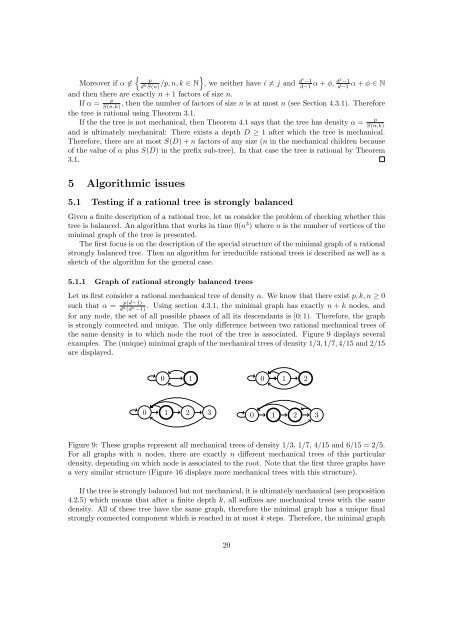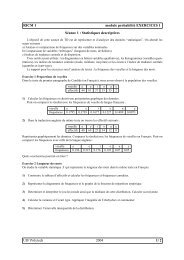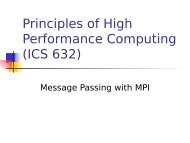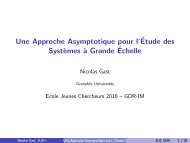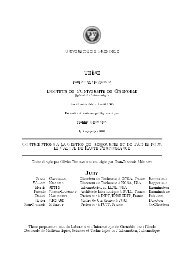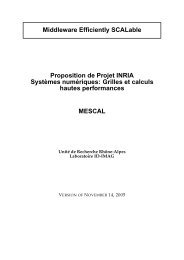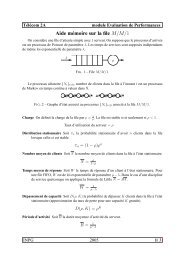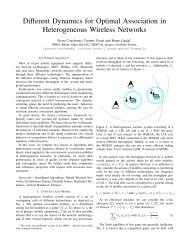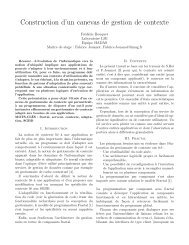Distributing labels on infinite trees
Distributing labels on infinite trees
Distributing labels on infinite trees
Create successful ePaper yourself
Turn your PDF publications into a flip-book with our unique Google optimized e-Paper software.
{ }Moreover if α ∉ pd k S(n) /p, n, k ∈ N , we neither have i ≠ j and di −1d−1 α + φ, dj −1d−1 α + φ ∈ Nand then there are exactly n + 1 factors of size n.If α =pS(n,k), then the number of factors of size n is at most n (see Secti<strong>on</strong> 4.3.1). Thereforethe tree is rati<strong>on</strong>al using Theorem 3.1.If the the tree is not mechanical, then Theorem 4.1 says that the tree has density α =pS(n,k)and is ultimately mechanical: There exists a depth D ≥ 1 after which the tree is mechanical.Therefore, there are at most S(D) + n factors of any size (n in the mechanical children becauseof the value of α plus S(D) in the prefix sub-tree). In that case the tree is rati<strong>on</strong>al by Theorem3.1.5 Algorithmic issues5.1 Testing if a rati<strong>on</strong>al tree is str<strong>on</strong>gly balancedGiven a finite descripti<strong>on</strong> of a rati<strong>on</strong>al tree, let us c<strong>on</strong>sider the problem of checking whether thistree is balanced. An algorithm that works in time 0(n 3 ) where n is the number of vertices of theminimal graph of the tree is presented.The first focus is <strong>on</strong> the descripti<strong>on</strong> of the special structure of the minimal graph of a rati<strong>on</strong>alstr<strong>on</strong>gly balanced tree. Then an algorithm for irreducible rati<strong>on</strong>al <strong>trees</strong> is described as well as asketch of the algorithm for the general case.5.1.1 Graph of rati<strong>on</strong>al str<strong>on</strong>gly balanced <strong>trees</strong>Let us first c<strong>on</strong>sider a rati<strong>on</strong>al mechanical tree of density α. We know that there exist p, k, n ≥ 0such that α =p(d−1) . Using secti<strong>on</strong> 4.3.1, the minimal graph has exactly n + k nodes, andd k (d n −1)for any node, the set of all possible phases of all its descendants is [0; 1). Therefore, the graphis str<strong>on</strong>gly c<strong>on</strong>nected and unique. The <strong>on</strong>ly difference between two rati<strong>on</strong>al mechanical <strong>trees</strong> ofthe same density is to which node the root of the tree is associated. Figure 9 displays severalexamples. The (unique) minimal graph of the mechanical <strong>trees</strong> of density 1/3, 1/7, 4/15 and 2/15are displayed.0 1 0 1 20 1 2 30 1 2 3Figure 9: These graphs represent all mechanical <strong>trees</strong> of density 1/3, 1/7, 4/15 and 6/15 = 2/5.For all graphs with n nodes, there are exactly n different mechanical <strong>trees</strong> of this particulardensity, depending <strong>on</strong> which node is associated to the root. Note that the first three graphs havea very similar structure (Figure 16 displays more mechanical <strong>trees</strong> with this structure).If the tree is str<strong>on</strong>gly balanced but not mechanical, it is ultimately mechanical (see propositi<strong>on</strong>4.2.5) which means that after a finite depth k, all suffixes are mechanical <strong>trees</strong> with the samedensity. All of these tree have the same graph, therefore the minimal graph has a unique finalstr<strong>on</strong>gly c<strong>on</strong>nected comp<strong>on</strong>ent which is reached in at most k steps. Therefore, the minimal graph20


